Introduction to Brand
The present paper is devoted to the description of the luxury fashion brand “Gucci” that belongs to the Kering Group (Binkley par. 11). Some of the ready-to-wear Spring 2017 Collection looks are presented in figure 1.

History of the Brand
As reported by WWD Staff, the first Gucci store was opened in 1921, and in 1935, Guccio Gucci developed the first Gucci signature: it is a diamond print on leather products that consists of small interconnected diamond shapes (see fig. 2). Since then, new stores were opening in Italy and other countries, and the products were becoming more diversified. For example, in 1966, the Flora print was designed, and in 1975, the company began to produce fragrances (see fig. 2). In 2004, the Kering Group raised its stake in the brand to 99%, but it did not affect Gucci’s success or identity; rather, the identity of the brand was changing together with its Creative Directors (WWD Staff par. 6-57). Gucci has had a very rich history of setting fashion trends, and nowadays, the brand is being renovated to maintain its reputation and status and develop its new identity with its new Creative Director.
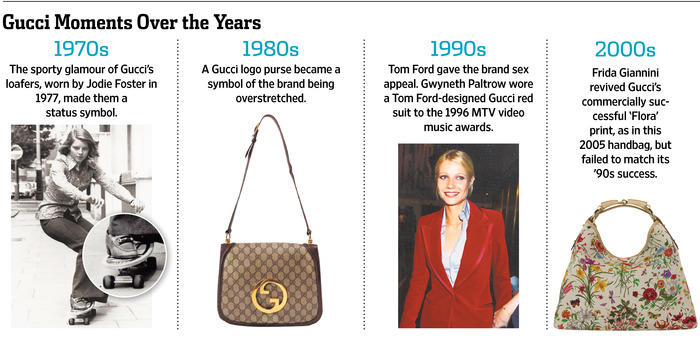
Mission Statement, Vision, and Values
Today, Gucci is being “reinvented,” and its strategic vision is being reconsidered by Marco Bizzarri, who is Kering’s current CEO in Luxury products. Bizzarri describes the reinvention of the brand as the renovation of its image in the effort to recapture “the spirit of innovation” and redefine the notion of luxury (“Kering Letter to Shareholders” 4). Bizzarri also has appointed Alessandro Michele as a new Creative Director who started to develop the new image of the brand.
The new vision is in line with the company’s mission statement and values: Gucci aims at strengthening the position of “the world’s most desirable fashion house” by proving its commitment to quality, innovation, and attention to details in its production (“About Gucci” par. 1).
Company Overview
Brand Structure
Nowadays Gucci belongs to the Kering Group as one of its brands; the Group tends to divide its brands into Luxury ones (Gucci, Yves Saint Laurent, Bottega Veneta, and others) and Sport and Lifestyles ones (PUMA and others) (“Kering 2016 First-Half Report” 11).
Financial Statistics
According to the “Kering 2016 First-Half Report,” the revenues of the Group have been growing steadily in the past four reporting periods; the second quarter of 2016 brought a 3.8% increase in the total revenues as compared to that of 2015. Gucci has also been experiencing growth in revenues that led to a 5.4% increase in 2016 so far; the brand was accountable for 50% of the Group’s revenue during the second quarter of the same year. Kering states that financial success suggests that Gucci reinvention was a successful decision. Also, the company reports a decrease in the net finance costs (25% in total), zero net loss from discontinued operations, and increases in earnings per share (10%).
Products, Prices, and Other Information
Even though Gucci belongs to the Kering Group, the company recognizes the specifics of all of its brands and offers separate information for every one of them. Gucci specializes in luxury clothes, footwear, and leather products as well as fragrances; its established markets include Western Europe, North America, and Japan; also, there are some emerging markets, including those in the Asian-Pacific region (except Japan), South America, and the Middle East. As a luxury, well-established, famous, high-quality, and high-end brand, Gucci goods have premium prices (“Kering 2016 First-Half Report” 11-21).
Distribution Channel Analysis
The key distribution channels of Gucci include specialty stores that are directly operated; also, in some countries, online purchases are an option (“Kering 2016 First-Half Report” 17). The first distribution channel is apparently in line with the brand’s high-end, luxury status; it offers the opportunity of communicating the brand’s identity through the environment in the stores and highlights the product’s uniqueness. The second option is a modern and convenient distribution channel that also can communicate brand identity through the content and design of the web pages. However, the reinvention of Gucci also involves the expansion of distribution channels to multi-brand stores, which has been promised by Bizzarri in 2015 (Bilefsky 7).
The aim of this action consists of finding more distribution opportunities and allies in the development and communication of the new brand image and making the distribution more extensive (Ferrell and Hartline 173). Finally, the increase in the number of stores and the redesign of distribution channels are also a part of Gucci reinvention. In particular, new stores with the new brand image have been opened in several capitals all over the world, and the website was redesigned, made more user-friendly, and filled with new content in 2015 (“Kering Letter to Shareholders” 6).
Operations
Gucci products are sworn to be made in Italy, which is “an integral part of the essence of Gucci” and helps the brand to remain linked to its historical heritage (“Made in Italy” par. 2). In 2015, 45,000 people were employed by Gucci Italian workshops, and its leather goods were claimed to be produced only there through handcraft (“Made in Italy” par. 4). Also, Gucci highlights ethical and respectful attitude towards all its stakeholders, including its suppliers and workers, and a part of its sustainability and corporate social responsibility efforts are directed at ensuring the ethical conduct throughout the production operations (“Corporate Sustainability and Responsibility” par. 1-2).
Marketing Strategy
Judging by the advertising campaigns (that are discussed below), the mission and vision of Gucci, and its pricing strategies, its products are aimed predominantly at the younger part of the high-income population of the established and emerging markets. These people are interested in high-quality, fashionable, sophisticated products as much as they are interested in the elite brand that would emphasize their fashion sense and individuality. Also, innovation and modernization are likely to be welcomed by the younger population.
The secondary target market is similarly wealthy, but the age restriction can be removed, and the older population can be considered. For this target market, the quality is also most important, but the brand is likely to be regarded as a status element. Naturally, the aesthetical appeal is of interest for both target markets. The essential marketing message of the product consists of its quality and sophisticated, but fashionable and modern nature. Gucci is a synonym of quality and high-end fashion, and this image should be embedded in the marketing message to evoke the expected response: the products should be regarded as a valuable addition to one’s wardrobe, and the company should be trusted, respected, and, in certain cases, idolized.
Personal selling is not among Gucci’s distribution channels. Gucci’s stores contain point-of-purchase promotion elements (Ferrell and Hartline 190). Indeed, displays are aimed at potential and existing customers and are supposed to help with a purchase decision. The strategy is long-term, although particular displays are short-lived due to the seasonal nature of fashion. A similar effect is created through website images, but this strategy is oriented towards the population that is are more interested in online purchases, which is likely to include the primary target market.
Gucci does not offer discounts or loyalty programs, being confident of having other means of attracting customers. Possibly, the opportunity to create an account on its website for convenient management of sales can be regarded as a form of sales promotion. This technique should attract the population that finds online shopping convenient, which is likely to include the primary target market.
The method should improve the customer’s experience by making repeated purchases more convenient, and it can be regarded as a way to attract customers more than once. Also, Gucci has a complimentary gift wrapping, which is likely to evoke a positive response from brand admirers since all the items (bags, boxes, ribbons) are Gucci’s signature. In general, though, Gucci aims for first-class service and wealthy users who do not require discounts; as a result, it may be suggested that the lack of typical promotion activities is promotional in making Gucci exceptional and highlighting its high-end status. All the mentioned techniques are long-term.
The majority of companies prefer combining various marketing techniques for the best effect (Ferrell and Hartline 188). Gucci uses different media channels, including social media for advertising, public relation, and sales promotion extensively (WWD par. 45; Strogatz par. 10-11). The method allows reaching both target populations along with the majority of other ones and communicating the brand’s image along with public relations activities (for example, those related to corporal social responsibilities) (“Corporate Sustainability and Responsibility” par. 1-2). It is a long-term strategy as such, but it may and is likely to be developed and changed with time.
Past Advertising Campaigns
Due to the reinvention, multiple advertising campaigns have been developed to reflect the new Creative Director’s vision in partnership with photographer Glen Luchford. The 2015 “On Set” (see fig. 3) aims to capture the “kinetic energy” of Alessandro Michele’s first collection (par. 1). The 2016 “Wild Wonderland” (see fig. 4), contains “riots of colors, textures and new prints” (par. 1). The 2017 “A Portrait of Chatsworth” (see fig. 5, fig. 6), searches to contrast the “grandiose, stately surroundings” of the Chatsworth House to “punk” looks of the models (par. 1).
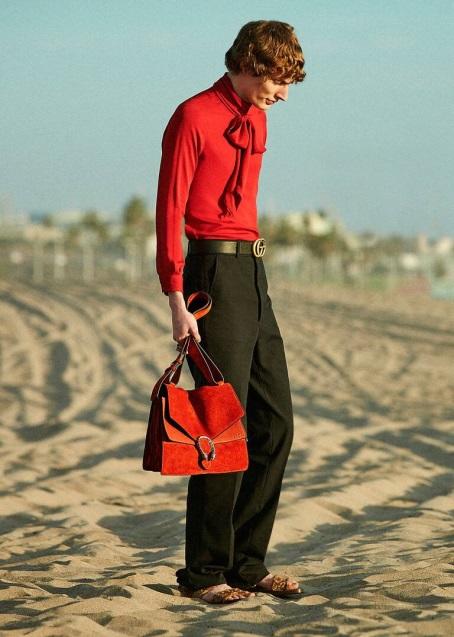
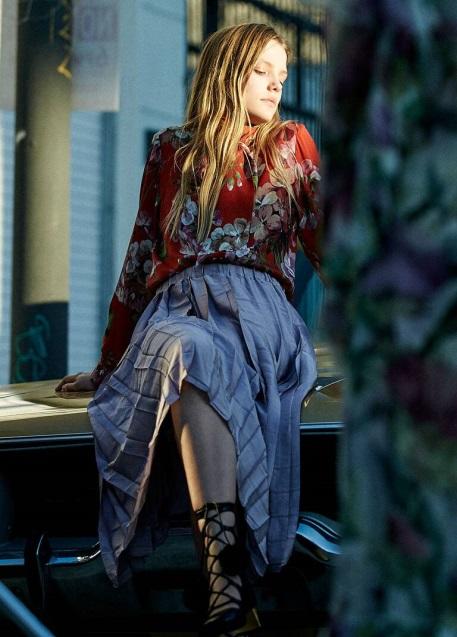
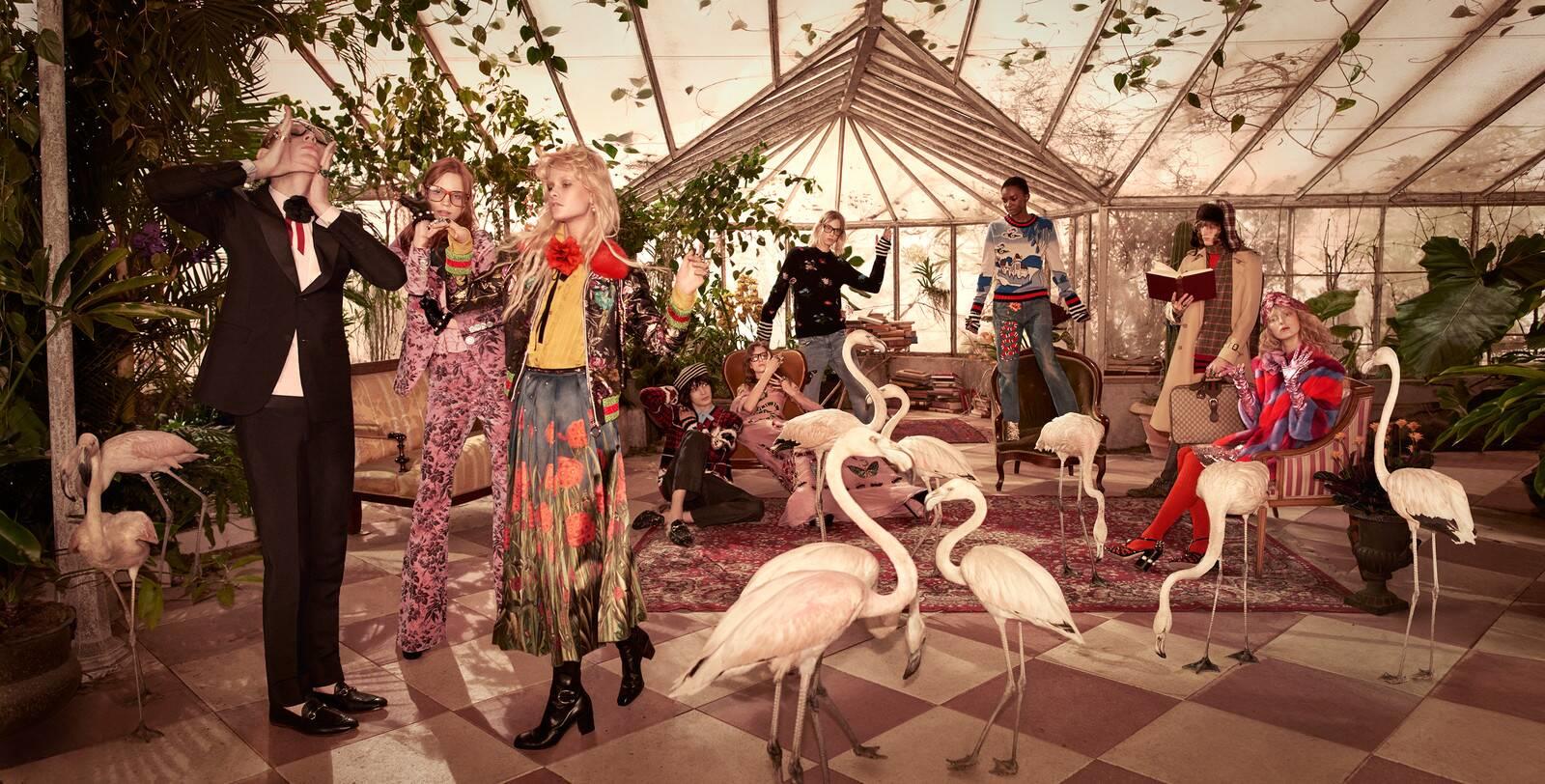
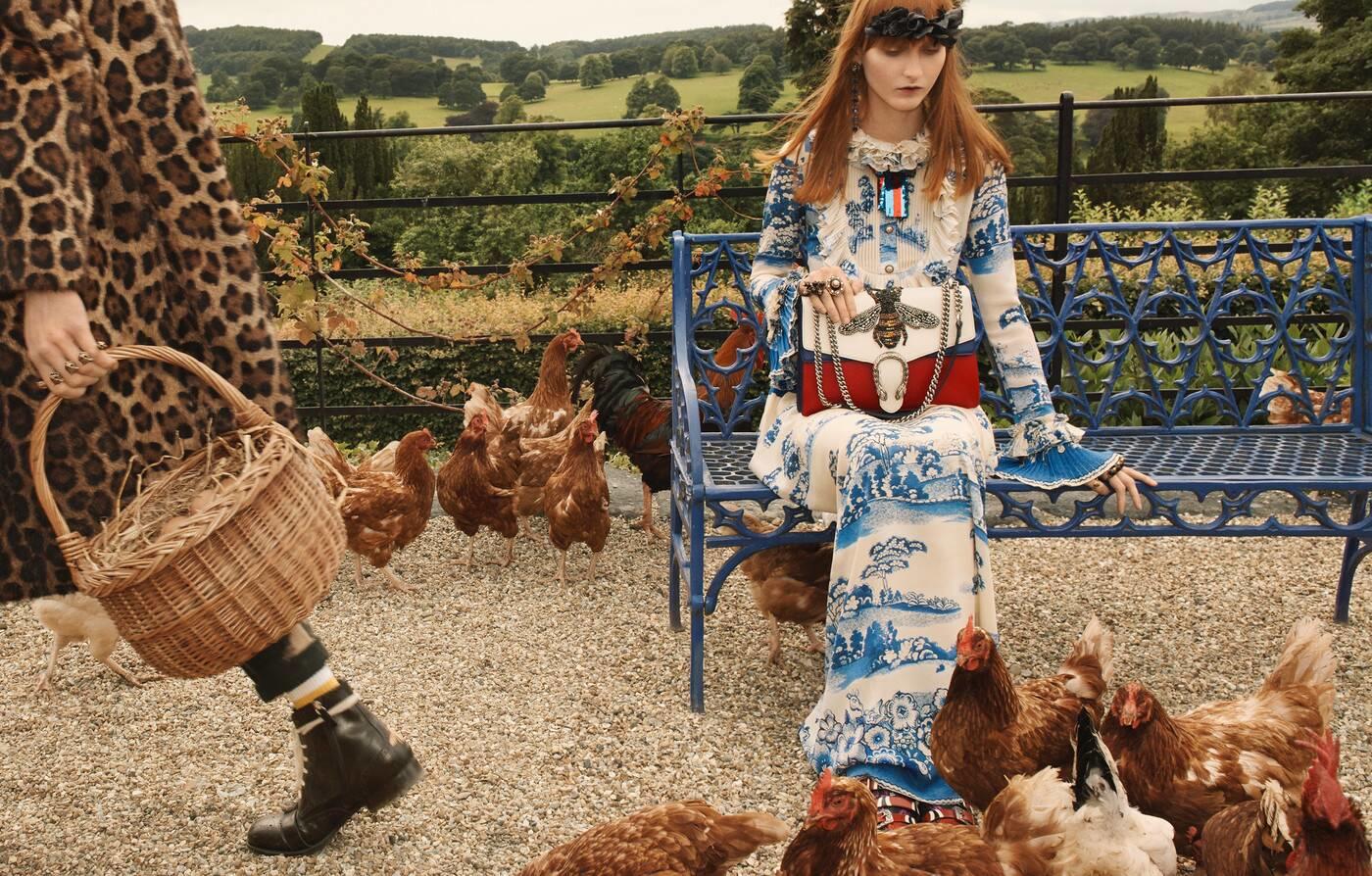
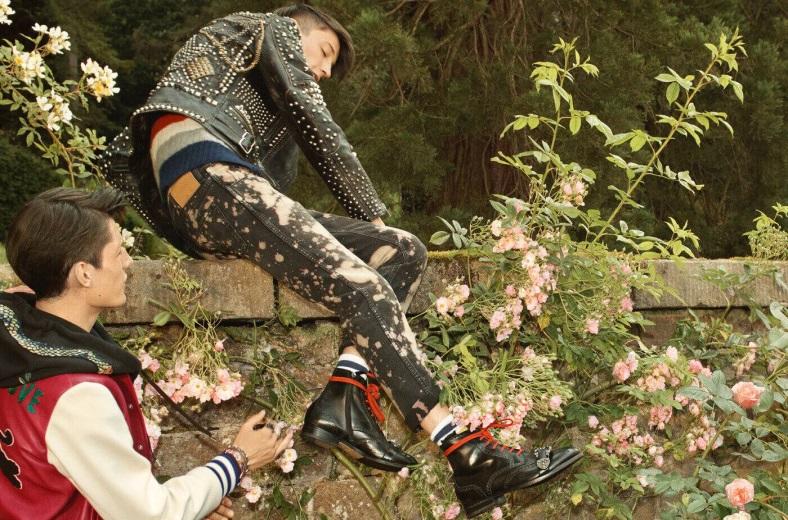

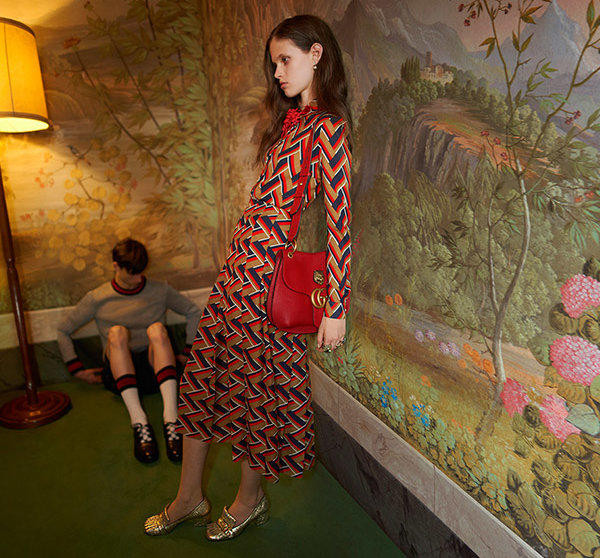
It can be suggested that advertising primarily targets young people and creates modern, sophisticated, and somewhat eccentric looks. Eccentricity, bohemian surrealism, and fairy-tale elements have already been recognized as characteristic of Michelle’s work (Bilefsky 7; Foley 2-4). Also, the people presented in the advertisements are slim or thin, and one of the models (see figure 7) was even deemed “unhealthily thin” by the Advertising Standards Authority of Britain, forcing the company to stop distributing this partial image in the country (Bilefsky 2-4).
While controversial, the decision signals the public concerns regarding potentially harmful imagery that leads to pressure on models and the majority of customers, and Gucci’s compliance can be regarded as a public relations activity. In the campaigns, advertised Gucci products (clothes, accessories, and shoes) create looks, which are complemented by varied settings.
Technologies and Innovations
Given Gucci’s mission statement and reinvention vision, it is clear that technological advancement is of importance for it. In particular, the website of the company was redesigned with modern opportunities in mind (“Kering Letter to Shareholders” 6). Similarly, the use of modern technologies for advertising has been eagerly developed by the brand and the company at large (Strogatz par. 10-11). Finally, the company’s dedication to quality and innovation also means that other its processes are being modernized (“About Gucci” par. 1).
Works Cited
A Portrait of Chatsworth 2016. Web.
About Gucci 2016. Web.
Bilefsky, Dan. “Model in Gucci Ad Is Deemed ‘Unhealthily Thin’ by British Regulator.”The New York Times. 2016. Web.
Binkley, Christina. “The New CEO behind the Gucci Moment.”The Wall Street Journal. 2015. Web.
Corporate Sustainability and Responsibility in 2016. Web.
Ferrell, Oliver, and Michael Hartline. Marketing Strategy. Mason, OH: South-Western/Cengage Learning, 2014. Print.
Foley, Bridget. “Gucci RTW Spring 2017.”Women’s Wear Daily. 2016. Web.
Kering 2016 First-Half Report 2016. Web.
Kering Letter to Shareholders 2016. Web.
Made in Italy 2015. Web.
On Set 2015. Web.
Strugatz, Rachel. “Social Media: Nobody Does It Better.”Women’s Wear Daily. 2011. Web.
Wild Wonderland 2016. Web.
WWD Staff. “Gucci: A History Lesson.”Women’s Wear Daily. 2011. Web.